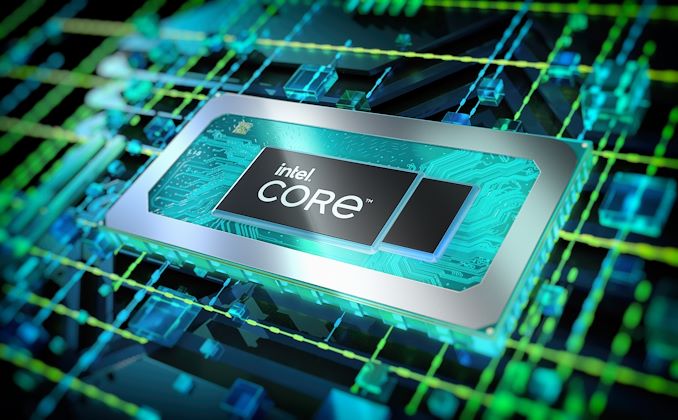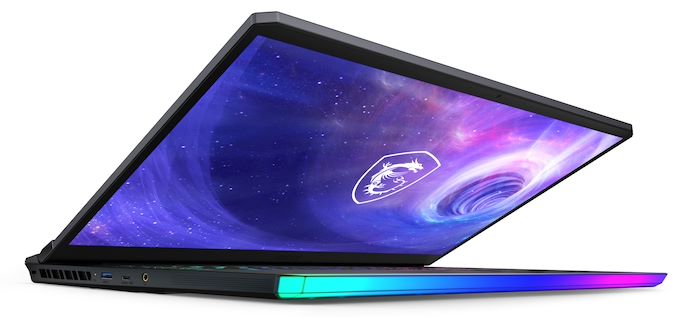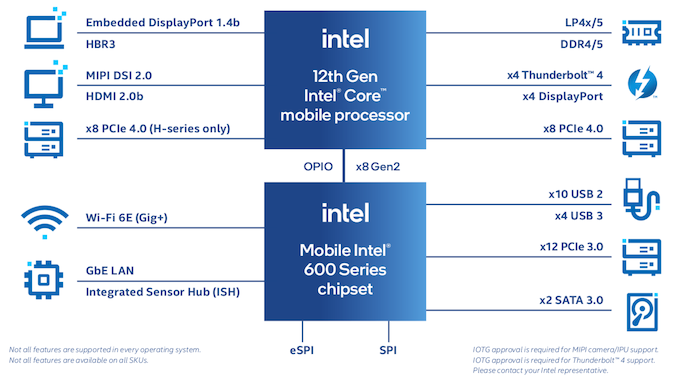Intel Alder Lake-H Core i9-12900HK Review: MSI's Raider GE76 Goes Hybrid
by Brett Howse on January 25, 2022 9:00 AM EST- Posted in
- CPUs
- Intel
- MSI
- Laptops
- Alder Lake
- GE76 Raider
- 12th Gen Core
- Alder Lake-H
_photo02_cr_678x452.jpg)
At CES this year, Intel officially announced its expanded Alder Lake processor lineup, including the performance-laptop focused H-Series chips, which traditionally fit in the 45-Watt range. For the last several processor generations, Intel has started their roll-outs with the low-power laptop parts, and then expanded the range up to and including desktop processors; but for Alder Lake they have flipped this on its head. Instead, Intel first launched desktop processors, such as the Core i9-12900K, and then moved down the range, with the performance notebook processors coming second, and the low-power processors coming later.
| Intel 12th Gen Core Alder Lake-H | |||||||
| AnandTech | Cores P+E |
E-Core Base |
E-Core Turbo |
P-Core Base |
P-Core Turbo |
Base W |
Turbo W |
| i9-12900HK | 6+8 | 1800 | 3800 | 2500 | 5000 | 45 | 115 |
| i9-12900H | 6+8 | 1800 | 3800 | 2500 | 5000 | 45 | 115 |
| i7-12800H | 6+8 | 1800 | 3700 | 2400 | 4800 | 45 | 115 |
| i7-12700H | 6+8 | 1700 | 3500 | 2300 | 4700 | 45 | 115 |
| i7-12650H | 6+4 | 1700 | 3500 | 2300 | 4700 | 45 | 115 |
| i5-12600H | 4+8 | 2000 | 3300 | 2700 | 4500 | 45 | 95 |
| i5-12500H | 4+8 | 1800 | 3300 | 2500 | 4500 | 45 | 95 |
| i5-12450H | 4+4 | 1500 | 3300 | 2000 | 4400 | 45 | 95 |
Today, we finally get to take a look at the 12th generation H-Series processors and see how they stack up to not only Intel’s previous 11th generation Tiger Lake platform, but also AMD’s Ryzen 5000 Mobile series. If you’ve not yet taken a look at the initial Alder Lake desktop processor review, definitely check that out since Alder Lake is a big departure from Intel’s traditional CPU design. Featuring a new hybrid CPU design with performance (P-cores) and efficiency cores (E-cores), the new design is more characteristic of what you would see in a smartphone platform, except Intel’s efficiency cores offer almost Skylake levels of performance and should not be disregarded.
Combined with Windows 11, Intel is hoping to improve multi-tasking performance with not only more cores, but also with Windows 11 being able to park jobs that are not in the foreground on the efficiency cores, leaving the performance cores available for the user to avoid system responsiveness problems even when the system is heavily loaded.
The Test System – MSI Raider GE76
Intel is putting its best foot forward, as expected, by supplying the MSI Raider GE76 system for performance testing. This 17-inch desktop-replacement machine is nearly always at the top of all notebook performance comparisons, and for 2022, MSI has kept the chassis the same, save for adding in Alder Lake as well as the latest NVIDIA RTX 3080 Ti Laptop GPU. We recently reviewed the Tiger Lake version of this notebook so if you want to learn more about the device, please check that review out. The Tiger Lake version was the fastest notebook we had ever tested, so expectations are high with the new Alder Lake refresh. We will be covering some of the same aspects here as well.
And for those that follow MSI, be aware that for 2022 they are moving the laptop name ahead of the model number, so it is now the Raider GE76, whereas last year it was the GE76 Raider.
| MSI Raider GE76 Alder Lake | |||||
| Component | As Tested | ||||
| CPU | Intel Core i9-12900HK 6 x P-Core, 8 x E-Core, 20 Threads 85 W TDP |
||||
| GPU | NVIDIA RTX 3080 Ti for Laptops 7424 CUDA Cores 16GB GDDR6 (16Gbps) |
||||
| RAM | 2 x 16GB DDR5-4800 | ||||
| Display | 17.3-inch 1920x1080 360 Hz | ||||
| Storage | 2 x Samsung PM9A1 1 TB NVMe PCIe 4.0 | ||||
| Networking | Killer AX1675 Wi-Fi 6E Killer E3100G Ethernet |
||||
| I/O | 1 x Thunderbolt 4 3 x USB 3.2 Gen 2 Type-A 1 x USB 3.2 Gen2 Type-C 1 x HDMI 2.1 1 x Mini DisplayPort 1.4 SD Card Reader Headset jack |
||||
| Keyboard | Steelseries per-key RGB Anti-Ghost | ||||
| Audio/Video | 1080p Webcam 2 x 2W + 2 x 1W Speakers |
||||
| Battery | 99.9 Wh Battery 330 W AC Adapter |
||||
| Dimensions | 15.63 x 11.18 x 1.02 inches | ||||
| Weight | 2.9 kg / 6.9 lbs | ||||
| Price (USD) | $3600 USD with single SSD | ||||
MSI checks all the boxes for 2022. Featuring the Core i9-12900HK, 32 GB of DDR5-4800 memory, the newest NVIDIA RTX 3080 Ti Laptop GPU, and not one but two Samsung PM9A1 1 TB NVMe PCIe 4.0 drives. MSI has improved their cooling solution for 2022 with a new Phase Change thermal pad as well, allowing the system to wick heat away from the hot components into the cooling system with even more efficiency.
The Core i9-12900HK Processor
At the top of the Alder Lake laptop product stack is the Core i9-12900HK processor. It features six of the new Golden Cove P-cores and eight of the new Gracemont E-cores. The P-Core can turbo up to 5 GHz, while the E-Core caps out at 3.8 GHz. The processor has a nominal TDP of 45 Watts – though in the case of our Raider, the TDP appears to be set closer to 75 Watts out of the box – with a peak turbo draw of up to 115 Watts. It offers up to eight lanes of PCIe 4.0 for graphics and two sets of four PCIe 4.0 lanes for storage, along with an additional twelve PCIe 3.0 lanes.
One of the big changes for Alder Lake-H is that Intel has taken a page from the design for their U/Y/P series chips and moved the formerly separate PCH on to the processor package itself. This essentially reduces Alder Lake-H to a single package solution, as like its other mobile brethren, no external silicon is required to provide necessary I/O functionality. By reducing ADL-H to a single package, this will allow for smaller form factor designs, as well as reducing the footprint that needs to be cooled.
The new processor can support up to 64 GB of memory, and supports DDR5-4800, LPDDR5-5200, DDR4-3200, and LPDDR4-4267. There are a plethora of PCIe lanes available with eight PCIe 4.0 lanes for graphics, two sets of four PCIe 4.0 lanes for storage, and an additional twelve PCIe 3.0 lanes. It can't quite match a desktop processor and chipset, and the laptop processors do not have support for PCIe 5.0 yet unlike their desktop counterparts, but it is still a significant amount of expansion available. There is also support for up to four Thunderbolt 4 ports for external I/O.
On the graphics front, the Core i9-12900HK offers Intel Iris Xe graphics with 96 Execution Units on tap with a peak GPU frequency of 1.45 GHz. This is a big step up in terms of integrated graphics from the Tiger Lake H-Series, which only provided 32 Execution Units of Intel UHD graphics. Laptop buyers will be unlikely to find the H-Series where it is not paired with a dedicated graphics card, but it is nice to see that the latest Alder Lake lineup does get access to the top-tier graphics regardless.















153 Comments
View All Comments
corejamz - Friday, February 4, 2022 - link
Awesome article keep it up guys <a href="https://corejamz.com/">Mp3 download</a>corejamz - Friday, February 4, 2022 - link
https://corejamz.com/sandeep_r_89 - Monday, January 31, 2022 - link
Depends on the performance plan, and other things like DPTF, plus the laptop manufacturer UEFI doing screwy things with respect to power management and heat.Too much nonsense gets in the way.
And of course Windows is always doing something in the background, and not actually allowing the CPU to sleep as well as it should. Can't get good battery life with E-cores if the P-cores can't actually turn off.
deil - Thursday, February 10, 2022 - link
That's kinda expected when your laptops is 330W on wall but 45 on battery ? Who would think a battery can provide consistently 115W for cpu alone, when it's not brick sized ? That's why AMD wins this IMHO, their laptops loose on a plug, but on battery they win soundly. There is another thing to be said about 250W of heat under your palm that 330W brick suggest.I think that if you would disconnect power while under load, this would just explode.
at_clucks - Wednesday, January 26, 2022 - link
Apple's M1 seems to be in ballpark performance (from the few benchmarks I've seen on ArsTechnica) so if you want battery powered performance you don't go for the 7lbs DTR gaming Christmas tree but more likely to the 4.5lbs Mac.On the other hand you gotta love a CPU focused review of a laptop subsequently comparing the storage performance to another machine's who's storage details get no mention as far as I can tell. I mean what's the point of showing me how much faster the 2 PCIe 4.0 SSDs in the MSI are compared to the 5400RPM SATA HDD in the Asus laptop? I'm glad it's class leading though...
jrocket - Wednesday, January 26, 2022 - link
Or better yet, a much more power efficient Ryzen laptop, so you don't have to run macOS.corinthos - Wednesday, January 26, 2022 - link
M1/Pro/Max provided optimized for your desired workloads. AMD Ryzen & 3070+ also do pretty well in terms of battery life. One really needs to test out their typical workloads to determine exactly how much battery life is gained by going Apple vs AMD, rather than just go by reviews based on reviewers' test scenarios. Also, being able to properly gauge how often you need to be unplugged is another thing to factor into a purchasing decision. If it's not as much as you think it would be, then you'll get more power for your dollar getting a desktop.Netmsm - Wednesday, January 26, 2022 - link
The title is about testing Alder Lake but actually it is about testing MSI laptop! Who in their right mind would consider this gaming tests as a justifiable review for Alder Lake?What are you doing Doc?
Spunjji - Thursday, January 27, 2022 - link
"the one where its performance is too poor for it to actually be used as a desktop replacement"Weird how often the benchmark level for "enough performance" magically moves to be as much performance as Intel provide...
evolucion8 - Wednesday, February 2, 2022 - link
So, a laptop with Ryzen 5800X/Radeon RX 6700XT class performance is not a desktop replacement? In which parallel world it isn't? With the fact that according to tests, it barely loses any CPU performance when unplugged and retains over 75% of its GPU performance as well?